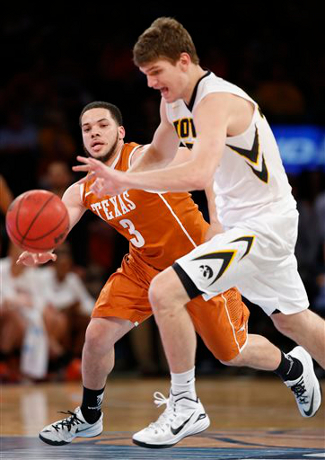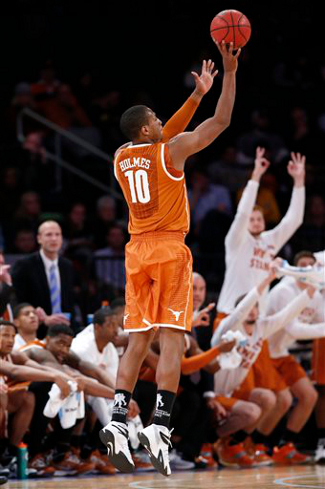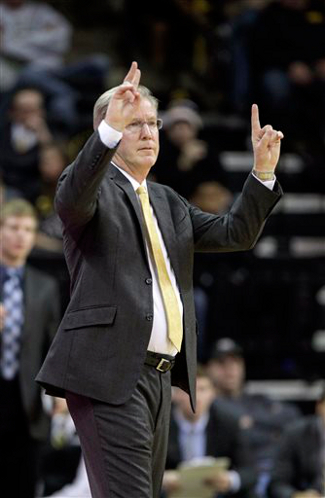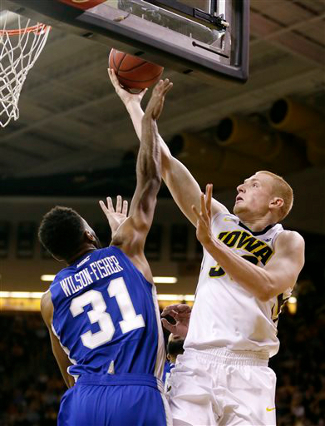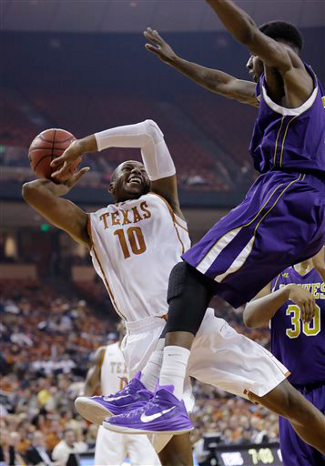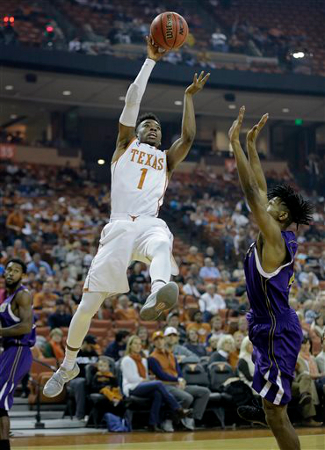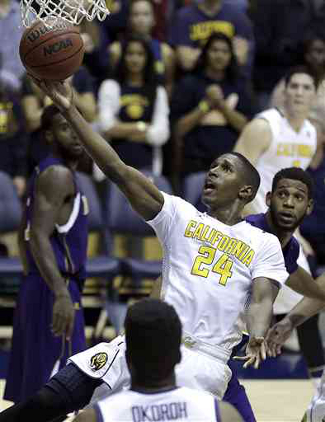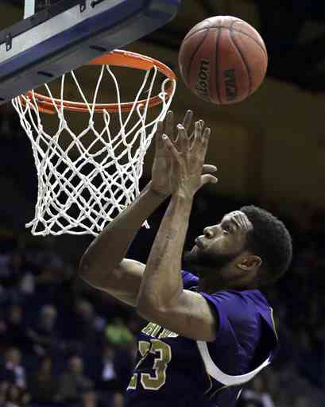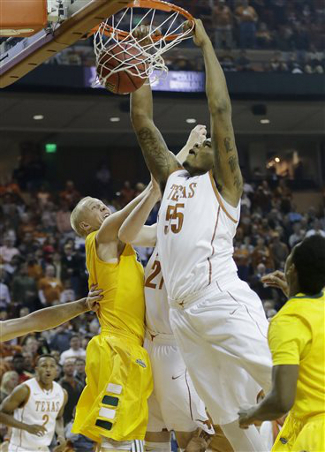After cruising through their first two games of the season, the Texas Longhorns took a major step up in competition against the Iowa Hawkeyes last night. The results were immediately disheartening, as the Longhorns quickly fell behind 13-2. The team missed point-blank looks, played carelessly with the ball, and gave up open three-pointers as they dug an early hole.
Texas coughed it up often in the first half In the first half, Texas turned it over on more than 25% of its possessions, shot just 32.3% from the field, and allowed Iowa an offensive rebounding percentage of 40.7%. Still, the Longhorns stayed within arm’s reach, and a strip by Javan Felix just before the half led to a fast break layup, cutting the Iowa lead to six at the break. The Longhorns stormed out of the locker room after the half, looking like a completely different team. Jonathan Holmes played with a fire that was completely lacking during a first half where he looked lost and frustrated. Isaiah Taylor flipped a switch and attacked aggressively with the bounce, while the team also fed the post with purpose and moved the ball quickly in early second-half possessions. Just 2:20 into the second half, Texas had charged into the lead for the first time, and quickly created a six-point margin. Aaron White tried to keep Iowa in the contest with a hard-nosed effort, bringing his team level again with 13:58 to play. The Longhorns immediately snuffed out the Hawkeye hopes with a 13-0 run and never looked back, building a lead as large as 19, en route to the 71-57 final. With the Cal Bears looming in tonight’s 2K Classic title game, here are five quick takeaways from Texas’ comeback victory: 1. The Texas D is going to keep them in games The first twenty minutes of last night’s game were maddening for Texas fans. After the team had looked downright dominant against two admittedly over-matched teams in North Dakota State and Alcorn State, the Longhorns suddenly played like they had in many frustrating losses over the last few seasons. Dumb turnovers, misses in and around the paint, and slow reactions to good, wide-open three-point shooters put Texas in an immediate hole. On some offensive sets, clearly frustrated players waited for others to make something happen. However, despite allowing the pair of early threes by Iowa’s Jarrod Uthoff, the Longhorns had a stifling defensive performance. Iowa could get no traction inside the arc, missing their first 14 two-point field goals, and finishing just 25% from the field in the first half. Texas also caused miscues on 20% of Iowa’s first half possessions, allowing the Longhorns team to trail by just six after a very tough first half. The suffocating defense gave Iowa no chance once the Longhorn offense turned it on after the break. Iowa finished the game just 29.6% from the field and scored just 0.839 points per possession. Although the Texas bigs were overly jumpy in the first half as they tried to block everything, and they were often faked into some dumb fouls, it seemed that the only place Iowa could score was at the line. Through three games, the Longhorns now have the nation’s sixth-best defense in terms of adjusted efficiency, according to Ken Pomeroy. Texas has allowed an adjusted 0.887 points per possession. While that number will certainly climb as the team faces a very tough schedule, it’s clear that the defense is going to keep them in games when the offense goes stagnant.
Jonathan Holmes was unstoppable in the second half 2. Jonathan Holmes is a bad, bad man When Texas stumbled through the first half, even Holmes was not immune to the struggles. The senior was just 1-for-4 from the field with a pair of turnovers in 13 first-half minutes, and the frustration was clear on his face as he headed to the bench for an early breather. At half, either Coach Barnes said the magic words to his lone senior, or Holmes found some vials of Five Hour Energy with Spinach. Jonathan scored the team’s first eight points after the break in just 85 seconds, and finished with 19 points and five boards. He drained 3-of-4 from behind the arc on the night, pushing his season total to 7-for-10, and giving him an offensive rating of 154.2 on the year. While the Longhorns have a slew of weapons to choose from, and freshman Myles Turner has earned a ton of preseason and early-season ink, the team clearly finds it tough to get going without Holmes. When the senior is scoring and stretching the floor with his outside shot, things open up for the rest of the Longhorns. 3. Taylor overcame a rough start The sophomore point guard had a frustrating first twenty minutes against Iowa, going just 1-of-7 from the field. Although he missed jumpers, Isaiah also was missing point-blank layups after making good moves to get the rack. He added a pair of free throws during the first frame, but scored just four first-half points. With Holmes and the Horns revitalized at the break, Taylor continued to attack with the bounce. Unfazed by his early misses, he posted a perfect 4-for-4 line in the second half and added another three free throws. He finished with 15 points, matching his season average, but did fail to log a single assist on the night. A hard foul from Iowa’s Gabriel Olaseni sent Taylor crashing to the floor in the game’s final minutes, and the point guard had his wrist heavily iced after the game, according to multiple media reports. Although Javan Felix has more than enough experience to run the point if needed, Texas would certainly miss Taylor’s slashing ability if he’s unable to go against Cal. 4. Lammert is quietly posting solid numbers On a night where it seemed like quite a few defensive boards were just out of reach for the Longhorns, Connor Lammert managed to again be the most consistent rebounder on the floor for Texas. The junior big man led the way with eight rebounds in just 20 minutes, with six of them coming on the defensive end. On the season, Lammert has a 22.6% defensive rebounding percentage, ranking him just outside the Top 200 nationally. Lammert also added two more assists, giving him a season assist rate of 31%, which does crack that Top 200. Oh, and have we mentioned that he has yet to turn it over? 5. The shot blockers have to stay grounded Turner and Prince Ibeh each picked up a pair of first-half fouls against Iowa, and added three more fouls in the second half. On the year, Ibeh is averaging 7.7 fouls per 40 minutes, while Turner is not far behind with 6.2 whistles. Both are clearly great shot-blocking talents, with Ibeh blocking nearly 9% of the two-point shots taken when he’s on the court, and Turner cleaning up an incredible 14%. However, both were overly jumpy last night, biting on the lightest shot fake, which led to foul trouble for them and free points for the Hawkeyes. Turner and Ibeh both have a ton of length that makes it tough for opponents to score inside. They need to trust that length and stand tall when isolated as the primary defender. If they can do that, they’ll be able to spend more time on the court, will force opponents into some very tough shots, and can save the highlight-reel swats for the times they’re coming over to clean things up as secondary defenders. Up next: vs. Cal at Madison Square Garden; Friday, 6:30 P.M. CT (ESPN2) |








